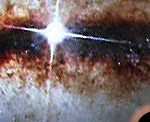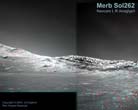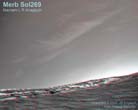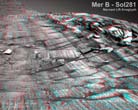Technically this image does not belong in this collection. I've included it
here for several reasons;
-
So newbies can compare the very different landscapes between the original and
new landers.
- So old-timers can compare the very different landscapes.
- So
relative image color, detail and quality can be compared between the old and
new landers.
- Because it's December and I wanted an atypical 'snow' scene on my
desktop.
I have processed this Viking image with the exact same software and techniques
as are applied to the Opportunity images. The results are close to identical
and these scenes appear close to the way you would perceive them if you were
there in person. The major difference is that in person the sky would appear
more whiteish with slight pink dust tinge along the horizon. The Opportunity
images below all have a bright blue sky because the 'Red' filter frequently
used is L2 which blocks some human visible red light and lets in red light
further in the infra-red range. This has the effect of 'streching' and
saturating the color somewhat. (i.e. subtract the some red from the sky and it
appears slightly more blue.)
The following images are sections of a full panarama of the inside of the
crater rim. It is steeper to the left and a bit shallower to the right where
Opportunity entered the crater. Rigt now (middle of December 2005) Opportunity
is moving slowly back toward its entrance point to leave this crater.
The soft dust dune area at the bottom of the crater is behind the rover in these
images. Ice clouds appeared over this area after these picture sequences.
|
|
 |
Sol 248. Close up of 'flow' section of pan. Opportunity image showing black
hematite 'flow' features down side of crater.
|
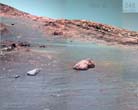 |
Sol 248. Part of pan section a of f.
|
 |
Sol 248. Part of pan section a1 of f. Close up of left side of pan.
|
 |
Sol 248. Part of pan section b of f.
|
 |
Sol 248. Part of pan section c of f.
|
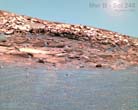 |
Sol 248. Close up of 'cliff' section of pan.
|
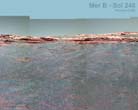 |
Sol 248. Part of pan section d of f.
|
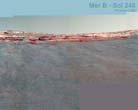 |
Sol 248. Part of pan section e of f.
|
 |
Sol 248. Part of pan section f of f.
|
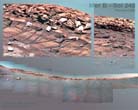 |
Sol 248. Full pan with 'flow' and 'Cliff' inserts.
|
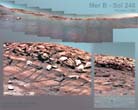 |
Sol 248 Full pan with inserts of 'Flow' and 'Cliff' sections.
|
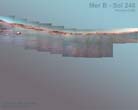 |
Sol 248. Full pan with no inserts.
|
|
|
 |
Sol 280. Forward view, three color images. Red is far(deep) red image. These
images are overlayed on a BW image of the same section.
|
 |
Sol 281. Black sand/dust is reflective in blue and green filters and NOT
reflective in IR. This indicates that it is most likely hematite dust created
by thousands of years errosion of the hemetite nodules from the surrounding
rocks.
|
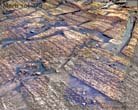 |
Sol 279. Rover is on side of crater to the left of 'flow' section of pan. Detail
of sediment ridges. The small long chips are probably the harder ridges
chipping off after erosion has removed softer layer material. Note dark
hematite sand topped with red dust 'swirls'. Also note grey-blue hematite
nodules.
|
 |
Sol 283. Close up of ground section. This shows more detail of layers and black
hematite dust/sand.
|
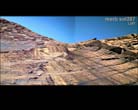 |
Sol287. A little further along crater wall. Opportunity's furthest image along
left side of eariler pan. This image is a near true color image. The red is in
the infra-red region (deep red) and this causes the sky to look a bit too blue.
To human perception the sky would appear more white with pink tones. The bluish
tinge on the ground at the left of the image is mostly a reflection from the
Hematite nodules and dust of the sky.
|
 |
Sol 287. Infra-red image from right pan camera. IR makes the sky very blue and
ground appear yellow. Notice the fairly thick layer of dark material which may
have been caused by different sea salinity or ph during a prehistoric period.
|
